Original Author: Stacy Muur
Translation | Odaily Planet Daily (@OdailyChina)
Translator | Ethan (@ethanzhangweb3)_
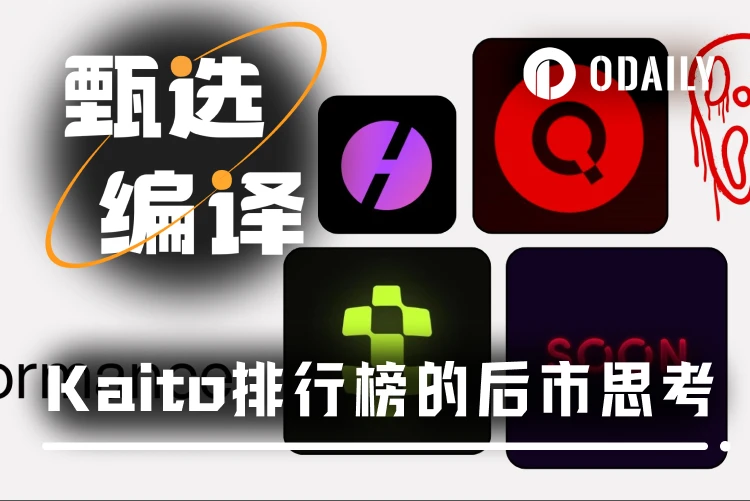
The memory of the new attention economy is fleeting.
The crypto space has always been narrative-driven. However, in 2025, a new mechanism for generating attention took center stage: @KaitoAI's Earn leaderboard. These incentive activities reward early researchers, commentators, and meme creators (commonly known as "yappers") who generate buzz before a project launches in exchange for future token allocations.
Today, this gameplay has become standard procedure:
Reward early mindshare
Fabricate a story
Create demand before TGE
It does work. The leaderboard brings exposure, trading volume, and social recognition. But the key question is: Can this attention be sustained?
Once the tokens are issued and the airdrop is claimed, the same "yappers" have already turned to the next hot topic before another token issuance. Prices decline, trading volume dries up, and participation wanes.
This article critically examines several Kaito-related projects: SKATE, HUMA, QUAI, and SOON, exploring whether the buzz generated by the Kaito model can be maintained after the token listing. The trend is evident: The narrative is designed to ignite, not to retain.
We start with SKATE.
Skate: High trading volume, major exchange listing, and stagnation after the Kaito hype
@skate_chain's native token SKATE is a token for a modular gaming layer built on Solana, launched with strong momentum. With listings on major exchanges including Binance and Bitget, along with deeply integrated Kaito Earn activities, SKATE entered the market with ample liquidity and exposure.
TGE: June 10, 2025
Issuance price (opening price): $0.06506
First-day closing price: $0.05094
First-day trading volume: $41.46 million
Initial FDV (Fully Diluted Valuation): approximately $65 million
Current price (July 7): $0.04065
Current FDV: approximately $40.65 million
Drawdown since TGE opening: approximately 37.5%
Current 24-hour trading volume (July 7): $8.46 million
Trading volume/market cap ratio (July 7): approximately 139%
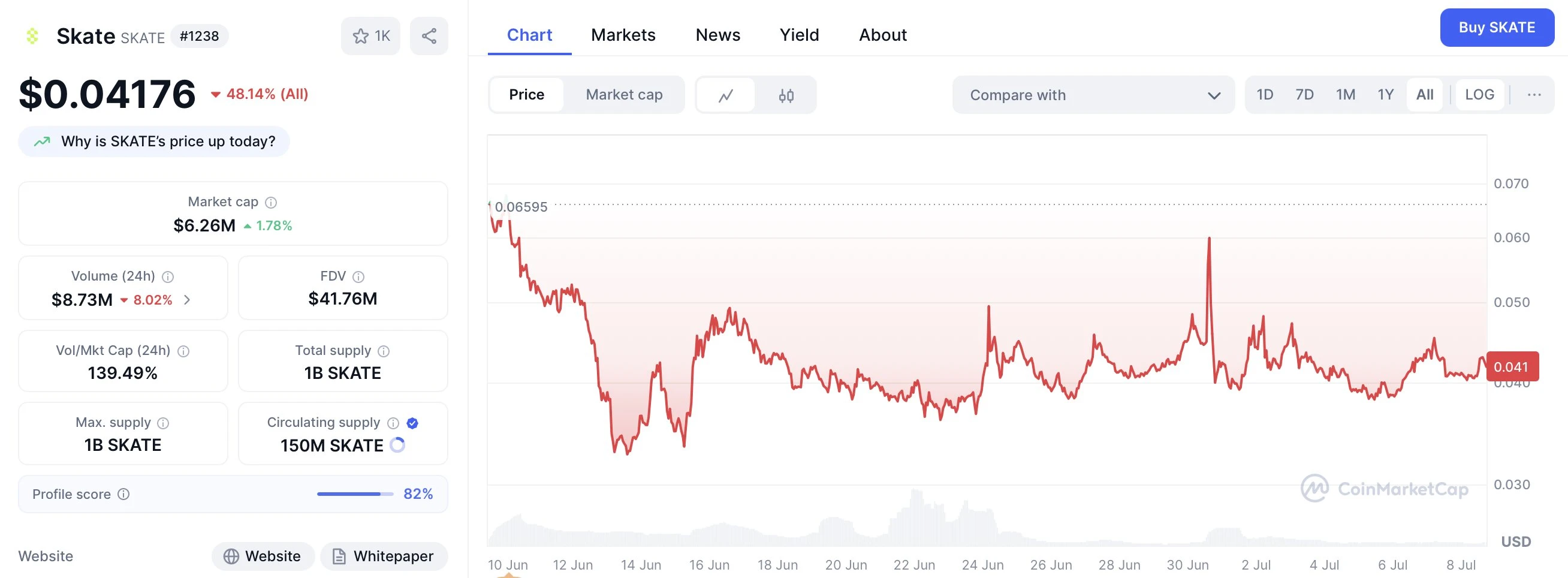
Price Trend: From Surge to Decline
The early trading of SKATE reflected a promising start. On June 10, interest in the token surged sharply, peaking at $0.06539, but quickly retraced, closing around $0.05094, a drawdown of about 22% on the first day.
What followed was a trajectory commonly seen in other Kaito-related projects:
Mid-June: A rebound supported by post-listing momentum to the $0.051 to $0.048 range (June 11–16)
June 21 to 23: Huge trading volume rotation (over $110 million in a single day), but no strong sustained direction
June 30 to July 4: Temporary fluctuations, with prices surging to $0.06234, then quickly dropping
July 5 to 7: Prices compressed to $0.04065, confirming a drawdown of about 37% since TGE and a drop of about 22% from the July 4 peak.
Social buzz also peaked early and quickly deteriorated. Within 7 to 10 days after the project launch, Kaito contributors shifted their focus to new leaderboard projects and unlaunched activities, leading to a noticeable decline in mention rates and participation.
Summary: Rotation > Retention
SKATE had all the favorable conditions: listing on mainstream CEXs, high liquidity, and a narrative driven by rewards within the Kaito ecosystem. But the attention did not last. Despite a daily trading volume close to 140% relative to market cap, SKATE remains a highly rotated rather than held asset.
Its story reflects that of other tokens in the Kaito Earn space:
Pre-issuance hype
Immediate trading volume driven by listing
Airdrop claiming and quick exits
Narrative exhaustion within weeks
The market behavior of SKATE reinforces the growing criticism of Kaito-driven project issuances: high exposure, low stickiness.
Huma: Launchpool Hype, 0.5% Kaito Rewards, and $300 Million in First-Day Rotation
@humafinance, a decentralized PayFi, launched its native token HUMA on May 26, 2025, with top-tier support from Binance and Kaito.
The Binance Launchpool activity allowed users to mine HUMA by staking BNB, FDUSD, or USDC from May 23 to 26. Meanwhile, Huma ran a Kaito Earn activity, allocating 0.5% of the total supply across three reward "seasons."
Season 1 allocation:
0.1% allocated to the top 500 Kaito yappers (30-day, 3-month, 12-month mindshare);
0.1% allocated to contributors in Solana, DeFi, and RWA categories;
Allocation limited to those who registered and held Kaito ecosystem tokens through SOL wallets.
Trading began on Binance at 13:00 UTC on May 26. As of May 27:
TGE (opening) price: $0.06683
First-day closing price: $0.05936
Drawdown since opening: approximately 11.2%
First-day trading volume: $310.37 million
First-day market cap: $102.89 million
Current price (July 7): $0.03083
Current market cap: $5.344 million
FDV (Fully Diluted Valuation): $308.6 million
Trading volume/market cap ratio (July 7): approximately 33%
Despite the heat generated by Launchpool and Kaito Earn, HUMA's trading activity remained primarily short-term rotation. Rewards from Season 1 were claimable from day one, and Season 2 was already announced, encouraging selling pressure rather than long-term holding.
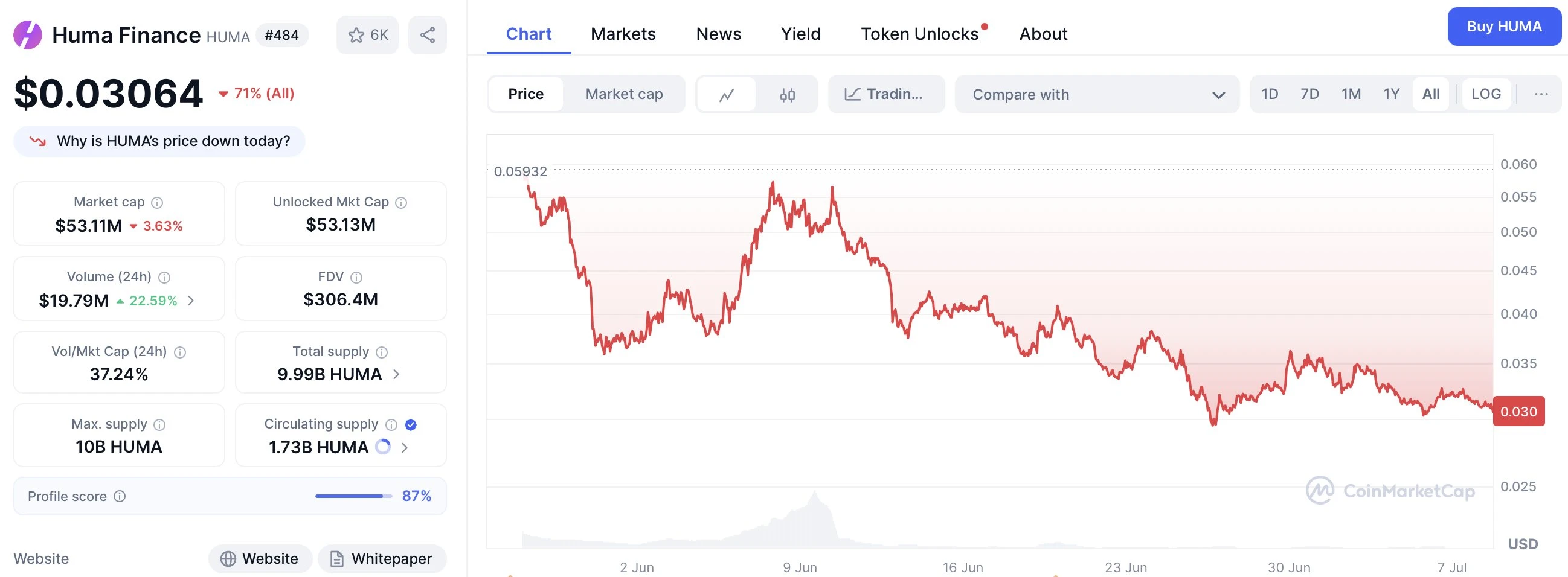
After briefly stabilizing around $0.05 in early June, the price steadily declined over the following month, dropping 40% from June 9 to July 7. This trend reflects not only profit-taking but also a broader phenomenon of lack of sticky demand. Daily trading volume fell over 90% from the first day's peak, and the widening gap between FDV ($308.6 million) and actual market cap ($5.344 million) reinforced the perception that most of HUMA's appeal is activity-driven rather than product-driven.
Summary
HUMA exemplifies the typical Kaito Earn model: grand in scale, abundant in liquidity, but lacking lasting appeal. This issuance was designed for exposure, not necessarily for conviction. Without post-issuance utility or demand hooks, the speed at which early attention rotates out is as fast as it rotates in.
Quai: Large Allocations, Deep Kaito Integration, Strong Start… Then Silence
@QuaiNetwork, a decentralized, multi-threaded blockchain protocol, has initiated one of the most generous and deeply integrated Kaito Earn activities to date. From January 17 to April 17, 2025, the project allocated a total of 6 million QUAI tokens as rewards for content contributors:
5.5 million QUAI for the general Kaito leaderboard;
500,000 QUAI for a dedicated Quai project leaderboard.
The claiming period was open from April 29 to May 12 via the Kipper platform. Weekly snapshots tracked contributors, with top yappers like @0xalank, @basedPavel, and @Abhijeetcg receiving as much as 5.95% of individual mindshare, far exceeding that of SKATE or HUMA.
Although the Quai mainnet launched on January 29, the tokens were not freely tradable until exchange data became available on February 22.
QUAI's first-day performance (February 22, 2025):
Opening price: $0.09884;
Highest price: $0.2263;
Closing price: $0.1929;
Trading volume: $10.14 million.
What happened next: Rotation, Reversal, and Long-term Cooling
QUAI recorded one of the most explosive debuts among all Kaito-related tokens. It surged from $0.09884 to $0.2263 within the day, an increase of 129%, closing at $0.1929.
But that was the peak.
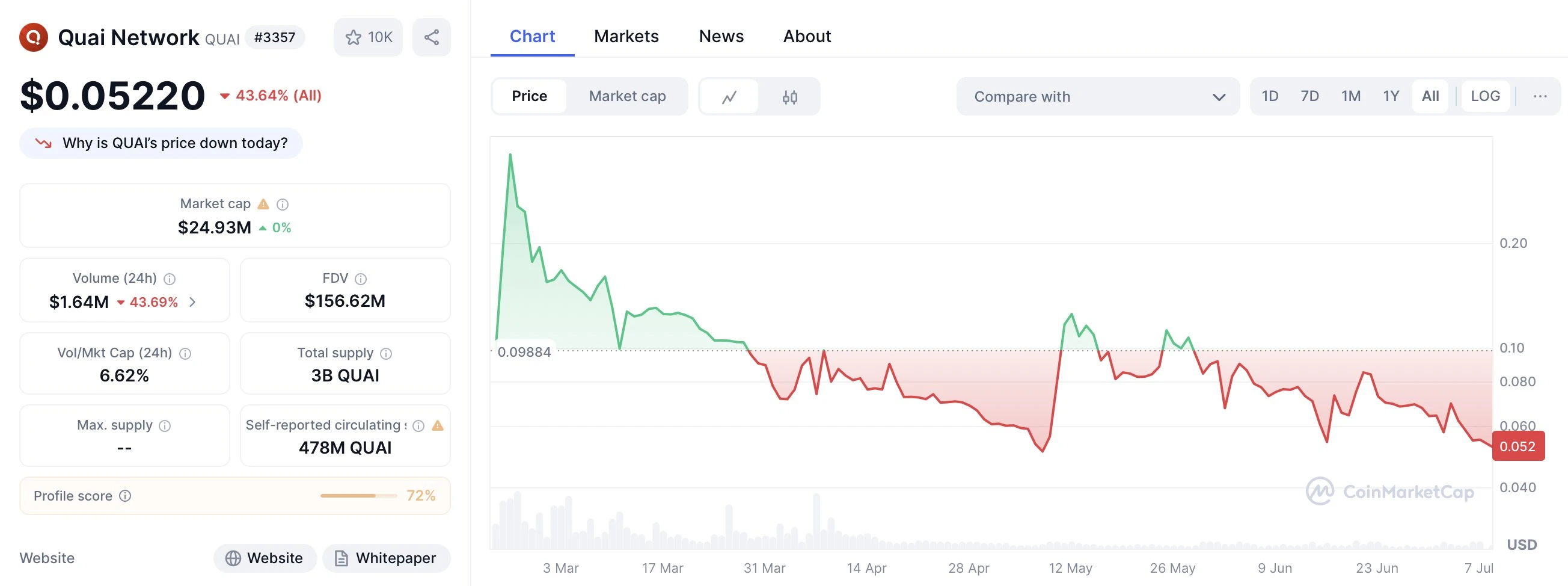
In the following weeks:
February 23 to 26: The price fell to the $0.17 to $0.18 range, with early rapid cooling.
March 1 to 15: A steady decline to the $0.12 to $0.08 range, showing a retracement pattern consistent with subsequent waning interest.
April to May: Despite some minor rebound attempts, support levels gradually weakened.
June to July: The token entered the $0.06 to $0.07 range, trading at $0.05266 as of July 7, down about 73% from the closing price and approximately 76.7% from the peak.
Trading volume also tells the story:
From $10 million on the first day to about $3 million now, with a sharp decrease in activity.
Even the second phase of Kaito rewards failed to significantly boost post-TGE demand.
Summary
QUAI had all the advantages: a massive Kaito allocation, strong brand synergy, a hyped TGE, and early price movements indicating momentum. But attention rotates quickly. Even top yappers with >5% individual mindshare could not sustain interest in the secondary market.
QUAI is now trading below its issuance price, with no meaningful recovery since March, making it a typical case study of “early liquidity ≠ lasting conviction.”
Soon: Kaito Synergy, Binance Alpha Buzz, and Harsh Reality Check
@soon_svm, a high-performance Solana Optimistic Network (SVM-based rollup), ran one of the most structured and community-synergistic Kaito Earn activities in early 2025. The project allocated 450,000 SOON tokens (approximately 0.045% of total supply) to the top 100 yappers during a three-month activity window.
Activity dates: February 19, 2025, to May 19, 2025;
Claiming period: May 23, 2025, to June 23, 2025;
Eligibility: Kaito leaderboard contributors, early NFT holders, builders badge owners;
Reward type: Token-based airdrop conducted via air drop.soo.network.
The activity was not just a reward distribution; it was embedded in SOON's identity. Participants were granted the "Sooner" role, badges, and social status, reinforcing the grassroots narrative that Kaito yappers were core evangelists for SOON.
TGE and Market Launch: From Hype to Decline
The SOON token was issued on May 23, with Binance Alpha listing starting trading on May 24. The token opened at $0.4527, briefly touching $0.4776, and closed at $0.4007. First-day trading volume soared to $103.1 million, showcasing strong speculative activity and the amplifying effect of the exchange.
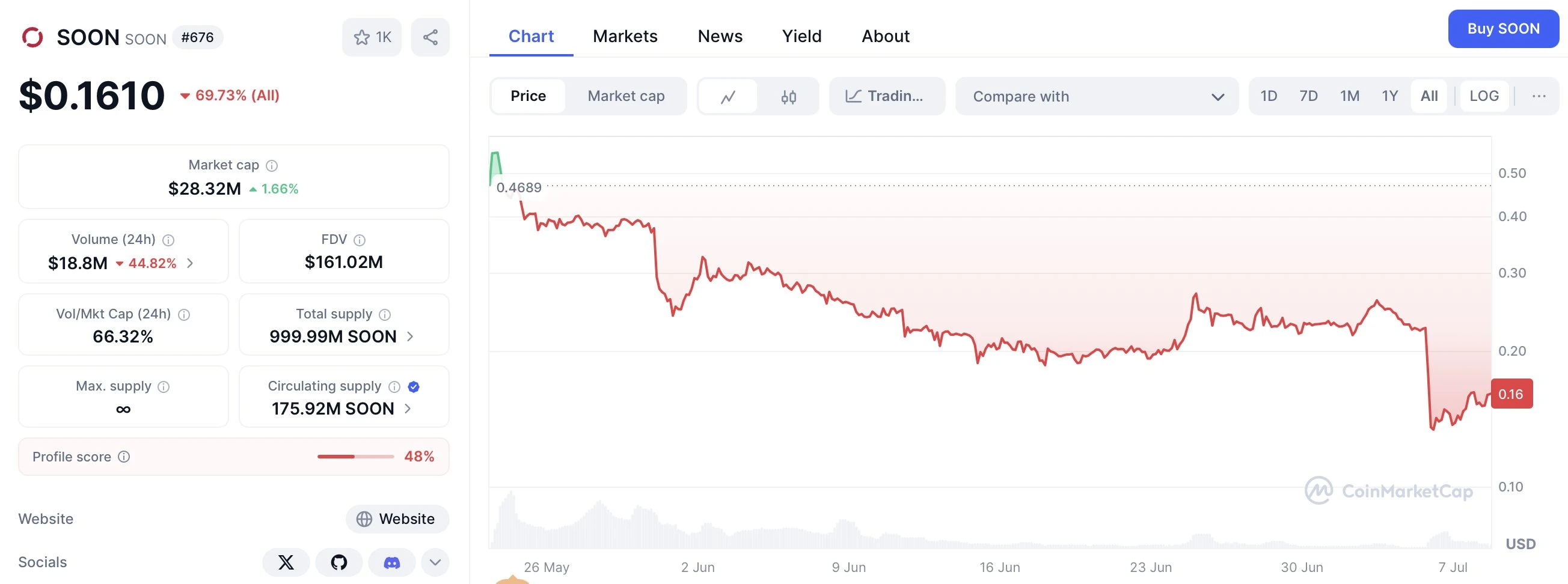
Market metrics (as of July 7, 2025):
TGE date: May 23;
First-day opening price: $0.4527;
First-day closing price: $0.4007;
First-day trading volume: $103.1 million;
Current price: $0.1529;
Market cap: approximately $26.9 million;
Drawdown since opening: approximately 66.2%;
Drawdown from the peak: approximately 68.0%;
Trading volume/market cap ratio (July 7): approximately 97%.
What happened after the first day?
Following the initial frenzy, SOON followed the now-familiar Kaito trajectory:
Late May to mid-June: SOON maintained in the $0.29 to $0.39 range, accompanied by moderate turnover and slow decay.
Late June: Support levels broke below $0.25, with trading volume accelerating downward from June 27 to 30.
July 5 to 7: SOON plummeted 40% in 48 hours, from $0.22 to $0.13, then slightly rebounded to $0.15.
This sharp decline coincided with the end of the claiming period (June 23), after which many claimants likely sold off, and attention shifted to other Kaito activities.
Summary: The Sooner You Sell?
SOON had all the elements for a successful launch: strong infrastructure promotion, exposure from Binance Alpha, and community-coded incentives. However, the token's 66% drawdown within six weeks indicates that the hype did not translate into conviction.
The Kaito Earn model has become predictable:
Narrative-driven airdrop → High first-day trading volume → Rapid airdrop rotation and sell-off → Price decline as attention shifts
Despite SOON's efforts to integrate into community culture, its market behavior serves as a case study in attention fragility. Its Kaito roots gave it a strong start but could not prevent the ensuing silence.
Conclusion: Cheap Narratives, Scarce Conviction
The Kaito Earn model has proven to be a powerful engine for pre-issuance exposure, but a consistent pattern has emerged among SKATE, HUMA, QUAI, and SOON:
Attention peaks at TGE but fails to convert into long-term conviction.
Despite differences in domains (gaming, infrastructure, PayFi), listing platforms (Binance, Bitget), and reward structures, the results are strikingly similar:
Tokens rise on the first day;
Airdrop recipients rotate out;
Price trends flatten within weeks.
This is not a failure of Kaito itself; as a content discovery layer, it performs well. But the current model incentivizes narrative creation rather than long-term conviction. Without actual utility, retention mechanisms, or sustained product demand, most tokens issued through this channel will fall into cycles of attention or exit.
Unless the token design can break this cycle, moving beyond mere speculation to reward holding, the Kaito model may remain just that: a powerful launch platform with few successful landings.
免责声明:本文章仅代表作者个人观点,不代表本平台的立场和观点。本文章仅供信息分享,不构成对任何人的任何投资建议。用户与作者之间的任何争议,与本平台无关。如网页中刊载的文章或图片涉及侵权,请提供相关的权利证明和身份证明发送邮件到support@aicoin.com,本平台相关工作人员将会进行核查。




